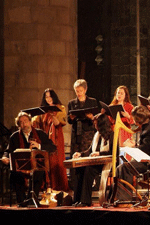> [Archived] Chronicles

Jordi Savall and Hesperion XXI in concert at the Romanian Athenaeum
I know this is not Jordi Savall's first concert in Romania, but is this your first visit to Romania?
No, this is my second visit. My first visit was last year, when I held a similar concert with the same Jordi Savall in Iași. The Romanian audience are wonderful. I am touched by the hospitality of the Romanian people; we can tell that you give us a heartfelt welcome every time. This evening I truly felt that I shared something with the audience.
I think you've been living in the ambience of Dimitrie Cantemir's music for quite some time now. Can you identify the atmosphere of his works in the Romanian cities you have visited, I mean in Iași and Bucharest?
Yes, more or less, in the facial features of Romanians. There are many things I recognize in the features of the people here, but they seem to also reflect something from the atmosphere of Cantemir's century. And I, as an Armenian, feel that there is also a resemblance between the two peoples - mine and yours.
These thoughts have been imparted to me by Haig Sarikouyoumdjian, a guest of the Hespèrion XXI ensemble, who performed Wednesday evening, on December 7th, on the stage of the Athenaeum. Hespèrion XXI accompanied the founder of the ensemble, Jordi Savall, and the hall was packed with people eager to listen to the famous musician.
The Book of the Science of Music, brought back to life by Savall
We have good cause to look up to him and not just because he is one of the most renowned music researchers or because he has reintroduced music lovers to the old repertoire, long forgotten. First of all, we should appreciate him for having made the effort of coming to Bucharest to hold a concert just two weeks after the death of his wife, soprano Monserrat Figueras, who was his life companion for more than 40 years.
There is one more thing for which he should be appreciated. The fact the he has turned his attention to The Book of the Science of Music by Dimitrie Cantemir. Wiping off the dust which had kept the works in this collection out of concert halls, he has selected some of the best of these works so as to record them and play them all over the world. Thus, countries completely unfamiliar with our cultural heritage have come to know the intellectual brilliance of our prince. It is wonderful to hear this music performed on period instruments and discover the artistic ferment of the Ottoman court. A tint of melancholy seems to permeate this music even in its merry moments. I would venture to say that it has a certain dramatic feeling about it, due to the wailing sound of the instrument called kamānche, emphasised by the percussion instruments: kanun, santur, sas. I saw the oud once more, an instrument used not long ago on the stage of the Radio Hall, by Anouar Brahem, whom you surely remember.
... the most beautiful way of holding a moment of silence
The moments which ended the two parts were very moving, because after the work performed by the Hespèrion XXI ensemble and Jordi Savall, the hall of the Athenaeum sunk into almost complete darkness and the audience were presented with recordings of Monserrat Figueras. Afterwards, the hall remained dark and no one clapped until the lights had been switched on. That was basically the most beautiful way of holding a moment of silence in the memory of Monserrat Figueras after listening to the performances of the recently departed soprano.
The people cheered with great enthusiasm. On behalf of a lady who was a member of the audience yesterday, here are the words that best describe last evening's event:
'Extraordinary. It's extraordinary.'
Translated by Ruxandra Câmpeanu and Raluca Mizdrea
MTTLC, Bucharest University














